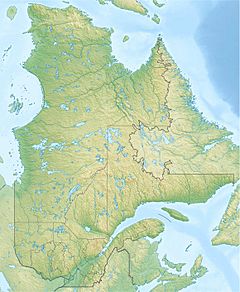Huron River (rivière du Chêne tributary) facts for kids
Quick facts for kids Huron River |
|
|---|---|
| Native name | Rivière Huron |
| Country | Canada |
| Province | Quebec |
| Region | Centre-du-Québec |
| MRC | L'Érable Regional County Municipality, Bécancour Regional County Municipality |
| Physical characteristics | |
| Main source | Agricultural and forest streams Laurier-Station and Notre-Dame-du-Sacré-Cœur-d'Issoudun 90 metres (300 ft) 46°33′03″N 71°38′46″W / 46.550756°N 71.646214°W |
| River mouth | Rivière du Chêne Leclercville (sector of Sainte-Emmélie) 60 metres (200 ft) 46°30′16″N 71°47′12″W / 46.50444°N 71.78667°W |
| Length | 20.6 kilometres (12.8 mi) |
| Basin features | |
| River system | St. Lawrence River |
| Tributaries |
|
The Huron River (or rivière Huron in French) is a river in Quebec, Canada. It flows into the rivière du Chêne, which then joins the mighty St. Lawrence River. The Huron River passes through several towns. These include Laurier-Station, Notre-Dame-du-Sacré-Cœur-d'Issoudun, Saint-Édouard-de-Lotbinière, Saint-Janvier-de-Joly, and Leclercville. It is located in the Lotbinière Regional County Municipality. This area is part of the Chaudière-Appalaches region of Quebec.
Contents
Where the Huron River Flows
The Huron River is part of a larger network of waterways. Rivers and streams often connect, forming a "watershed" or "drainage basin." This is an area of land where all the water drains into a common river, lake, or ocean.
Nearby Waterways
The Huron River has many neighbors in its watershed. Here are some of the main ones:
- North: Boucher arm, rivière du Bois Clair, Petit Saut river, Noire River, and the huge St. Lawrence River.
- East: Bois Franc-Pierreriche stream, Bourret stream, Rouge River (Beaurivage River tributary), rivière aux Pins (Beaurivage River tributary), and the Beaurivage River.
- South: Rivière aux Ormes (Huron River tributary), Rivière aux Cèdres, and the Rivière du Chêne.
- West: The rivière du Chêne.
The River's Journey
The Huron River starts where two smaller streams meet. One of these is called the "Head of the Huron River" stream. This starting point is near the village of Laurier-Station. The "Head of the Huron River" stream flows for about 7.6 kilometres (4.7 mi). It drains water from parts of Saint-Flavien and Laurier-Station.
From its source, the Huron River travels about 20.6 kilometres (12.8 mi). Along its path, the river drops about 30 metres (98 ft) in elevation.
River Sections
The river's journey can be broken down into several parts:
- First part: It flows about 1.2 kilometres (0.75 mi) first northwest, then northeast. It crosses Route 271 and meets the Bois Franc-Pierriche stream.
- Second part: It continues about 2.6 kilometres (1.6 mi) northwest, reaching Route 271 again.
- Third part: It flows about 3.7 kilometres (2.3 mi) westward, reaching the border of Saint-Janvier-de-Joly.
- Fourth part: It travels about 3.0 kilometres (1.9 mi) southwest. This section marks the border between Saint-Janvier-de-Joly and Notre-Dame-du-Sacré-Cœur-d'Issoudun. It then reaches the border of Saint-Édouard-de-Lotbinière.
- Fifth part: The river winds for about 8.9 kilometres (5.5 mi) (or 5.0 kilometres (3.1 mi) in a straight line) southwest. It reaches the border of Leclercville.
- Final part: It flows about 1.2 kilometres (0.75 mi) west within Leclercville. This is where it joins the rivière du Chêne.
The Huron River officially ends when it flows into the east bank of the rivière du Chêne. This happens in a place called the Lucieville Range, located in Leclercville.
About the Name
The name "Rivière Huron" was officially recognized on December 5, 1968. This was done by the Commission de toponymie du Québec. This commission is responsible for naming places in Quebec.


